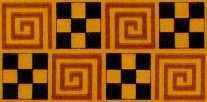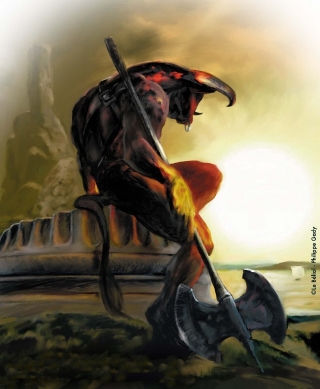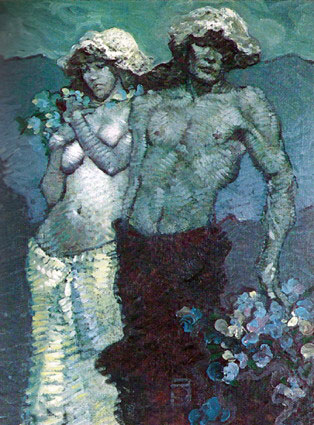III. THOMAS BURNETT SWANN: ODDS & ENDS...
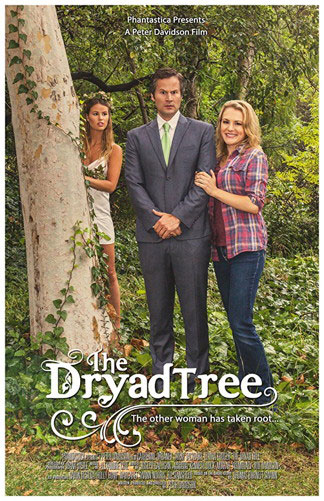
§ 2017 saw the release of a short film based on Swann’s story “The Dryad Tree.” Visit the movie’s page at IMDb for more details.
§ What books and authors influenced Swann? “The first and greatest influence—A.A. Milne’s Winnie the Pooh…Tolkien not at all, at any time, since I’ve only read The Hobbit, which I admire but don’t adulate.” Read more from the only interview with Swann ever published.
§ In 2011, Wildside Press began issuing new editions of Swann’s work. As of late 2012, these include THE FOREST OF FOREVER (hardcover, paperback and Kindle), GREEN PHOENIX (hardcover, paperback and Kindle), QUEENS WALK IN THE DUSK (Audible audio edition), THE GODS ABIDE (Audible audio edition), and THE DOLPHIN AND THE DEEP, included in the anthology THE WILDSIDE BOOK OF FANTASY.
§ At Facebook: Into the Wanderwood: A Thomas Burnett Swann Appreciation Group.
§ The January 30, 1956 issue of TIME Magazine included this letter signed “Thomas Burnett Swann, Winter Haven, Fla.”:
- The Word on Lola Sir: I was distressed to read in your Jan. 2 issue the description of the incomparable Lola Montez as a “hussy.” My dictionary defines “hussy” as a “worthless creature,” and surely a woman who was able to counsel kings and inspire geniuses was not worthless, and her mastery of the arts of love was a supreme accomplishment...
See the letter at TIME’s web site here; see the original story here.
§ Currently, where in the world is Swann most widely read? Perhaps in France, where several of his books have come back into print in recent years. These include LA TRILOGIE DU MINOTAURE, complete in one volume; his novel featuring Thomas Chatterton, THE NOT-WORLD (LE FORÊT D’ENVERS-MONDE) in a volume that also includes the novel THE GODS ABIDE (LES DIEUX DEMEURENT) and the short story “The Painter”; and his novels about the mythic origins of Rome, under the series title “Le Cycle du Latium,” including GREEN PHOENIX (LE PHÉNIX VERT), QUEENS WALK IN THE DUSK (LE PEUPLE DE LA MER), and LADY OF THE BEES (LA DAME DES ABEILLES). The French translations have received enthusaistic reviews at actusf.com and at climaginaire (search their site for further Swann reviews). A detailed bibliography of Swann’s publications in France can be found at nooSFere. There is also a Wiki page in French about Swann and his books.
§ Swann apparently wrote a regular column for the WFSA Journal, a monthly fanzine published by and for members of the Washington Science Fiction Association; see a reference to one of his columns (about King Kong, published in 1971) here. If you know the dates and titles or other details of his contributions, please contact steven@stevensaylor.com.
§ The online Wikipedia entry for Thomas Burnett Swann is packed with information.
§ The most complete bibliography of Swann’s works and the most extensive biographical information about him are to be found in the hardback omnibus THE MINOTAUR TRILOGY (1996), which contains an introduction by Charles de Lint; “A Critical Introduction” by Robert A. Collins; an exhaustive international bibliography compiled by Mathew D. Hargreaves; and the complete texts of the novels CRY SILVER BELLS, THE FOREST OF FOREVER, and DAY OF THE MINOTAUR, along with Swann’s essay “The Dryad.” The 452-page volume, with color endpaper illustrations by George Barr, may be available at Amazon or directly from the publisher. Contact: mathewdh@q.com
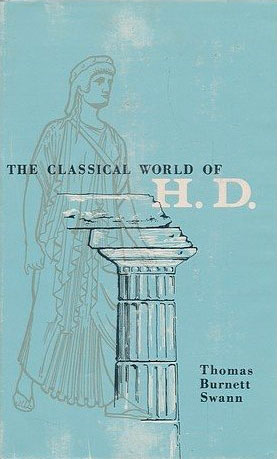
§ How insightful was Swann as a literary critic, and did he know Latin and Greek? This comment is by Robert G. Babcock of Yale University, from his review of H.D. AND HELLENISM by Eileen Gregory (Cambridge, 1997), which appeared in Bryn Mawr Classical Review 2000.03.23:
“The first monographic study of H.D. was also the first extensive treatment of the influence of classical sources on her work, Thomas Burnett Swann’s THE CLASSICAL WORLD OF H.D., published in 1962. Swann freely admits that he is unable to judge her translations, not knowing the classical languages. He turned to H.D. herself for assistance in identifying allusions or sources that escaped him, including Simaetha, the enchantress of Theocritus’s Second Idyll. But one cannot quibble with Swann’s delicate appreciation of H.D.’s poetry, and one would still today gladly give his book to an undergraduate looking for an orientation to H.D.’s Greece.”
§ Mike Heron of The Incredible String Band was inspired by Swann’s novel WOLFWINTER when he wrote the song “Ithkos”; the story can be read at this page. An extended live version of the song is available on the cd First Girl I Loved, or from iTunes.
§ “The Borrowed Bear,” a brief homage to his sources and inspirations written by Swann and first published in 1968, can be read online in the archives of the WSFA Journal, and answers this burning question: Which author influenced Swann more, Mary Renault or A.A. Milne?
§ The Old Gods Never Die: The Wisdom of Thomas Burnett Swann is an online collection of aphorisms and epigrams gleaned from Swann’s writings.
§ What were Swann’s best works?
- “Where Is the Bird of Fire?” was the story that put Swann on the map. When it was first published in 1962 in the British magazine Science Fantasy, the story “received more praise than any other in recent years,” according to the magazine’s editor, John Carnell. It was subsequently nominated for a Hugo Award, and Swann later expanded it into the novel LADY OF THE BEES.
- “WOLFWINTER, the Aeneas Trilogy (QUEENS WALK IN THE DUSK, LADY OF THE BEES, and GREEN PHOENIX) and the Minotaur Trilogy (CRY SILVER BELLS, THE FOREST OF FOREVER, and DAY OF THE MINOTAUR) are acknowledged as the highpoints of his career.” —Roger Clark Schlobin, “The Minotaur Trilogy by Thomas Burnett Swann,” in THE SURVEY OF MODERN FANTASY LITERATURE
- “HOW ARE THE MIGHTY FALLEN, written during Swann’s first bout with cancer...represents the peak of his powers. Swann called HOW ARE THE MIGHTY FALLEN ‘my starkest book, but also, at the end, my happiest.’... It was to be his greatest critical success.”—Robert A. Collins, “Thomas Burnett Swann: A Critical Introduction” • “La relecture de l’histoire biblique de David et Jonathan [est] sans aucun dout l’un des plus beaux romans de Swann.” —André-François Ruaud • Baird Searles in his review in The Village Voice called it “his best yet.” • Conversely, Diana Waggoner in THE HILLS OF FARAWAY asserts, “Most of the story concerns the homosexual love of David and Jonathan and is remarkably bad,” then adds (in a nakedly homophobic non sequitur!) “but the love scenes are not explicit.” See a further note on the novel below.
- In the anthology UNICORNS!, editors Gardner Dozois and Jack Dann assert that “The Manor of Roses” (later incorporated into the novel THE TOURNAMENT OF THORNS) was “probably his best story, and one of the best of all modern fantasy novellas.” Diana Waggoner in THE HILLS OF FARAWAY calls the story “brilliant” and “Swann’s most successful tale.” It was nominated for the Hugo Award for best novelette in 1967.
§ When asked, “Who were your influences?” author Mercedes Lackey replied: “In order of influence: Andre Norton, J.R.R. Tolkien, Robert Heinlein, Theodore Sturgeon, Thomas Burnett Swann, Anne McCaffrey, C.J. Cherryh, Marion Zimmer Bradley.”
§ The elusive Hugo: Although Swann never won either award, he was nominated several times for both the Hugo Award (science fiction’s most coveted prize) and the Mythopoeic Award (given for fantasy in the Tolkien tradition). He was also frequently cited in the runner-up listings for the Locus Award, determined by an annual readers’ poll conducted by the science fiction trade journal Locus. Here is a list of his nominations and citations, with links for more information:
§ Postscript to the above: “Richard Lupoff contends that this [“Where is the Bird of Fire?”] should have won the Hugo Award for best short story.”
§ In 1973, Swann received the Phoenix Award, given by the Southern Fandom Confederation, convening that year in New Orleans.
§Swann’s delight in the pagan sexuality of his characters, including same-sex relationships, won him a devoted gay and lesbian readership. HOW ARE THE MIGHTY FALLEN, with its love story between David and Jonathan, was a finalist for the 2000 Spectrum Awards Hall of Fame, sponsored by the Gaylactic Network. Read a lengthy review of the novel here.
§ This blurb attributed to Swann appeared on the back cover of the 1969 Ace paperback edition of Roger Zelazny’s novel ISLE OF THE DEAD: “Roger Zelazny can be as realistic as Hemingway, as fanciful as Kenneth Graham; he is by turns a hard-nosed naturalist and a poet of exquisite sensibility. ISLE OF THE DEAD is a book with illimitable excellences.”
§ The poet Charles Ghigna, aka Father Goose, recalls Swann as a memorable teacher: “Swann was my professor at Florida Atlantic University in the 1960s, a brilliant and inspiring mentor, a major influence on my early writings. His eccentric nature and the unusual tone of his lectures made us all sit on the edge of our seats hanging on his every word. He was always wide-eyed and exuberant in telling tales about H.D. and others whose work he not only admired and studied, but personally knew! We were all so impressed and wanted to be a part of that magical world of writers and imagination. He was a kind, thoughtful gentleman. I remember attending one of his parties at his condo overlooking the gulf. Like him, even the hors d’oeuvres were unique. It was the first time I had ever seen or tasted fried banana chips. But it was his voice that we remember. I can still see his expressive eyes and wild, nervous hands move like frightened birds in flight as he told stories in class in that memorable loud-whisper that seemed to say, ‘Listen to this...’ I think he would be proud to know that we’re still listening.”

Swann’s grave marker in Lakeside Memorial Park, Winter Haven, Florida
§ Swann’s simple grave marker is pictured above. Below: One of his loveliest poems, “Beautiful Is Dust,” was engraved, at her request, on the stone of Sheila Lane Beardsley, whom he knew in life; the two enjoyed playing tennis, and she drew illustrations for his book Wombats and Moondust. Click here or on the photo to see a larger, more legible image, and a newspaper clipping of the poem.
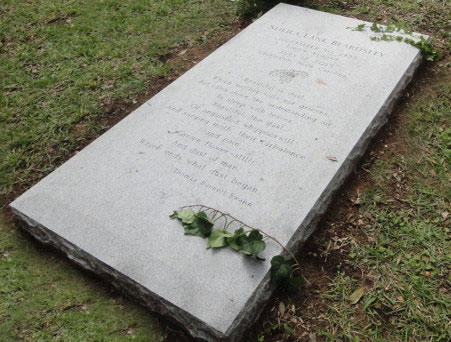
§ Memorials to Swann:
- Thomas Burnett Swann Memorial Award in English, Florida Atlantic University. “Established in 1985 by Dr. Margaret Swann, in memory of her son, FAU Professor Thomas Burnett Swann. Scholarships are awarded annually to graduate students majoring in English, with an emphasis in creative writing.”
- Thomas Burnett Swann Poetry Competition, sponsored by Seminole State College in Sanford, Florida. Winners of this annual competition receive a cash prize and their selected poems are published in the journal Revelry.
|
